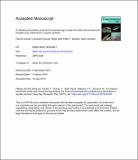A miniature biomimetic sonar and movement tag to study the biotic environment and predator-prey interactions in aquatic animals
Abstract
How predators find, select and capture prey is central to understanding trophic cascades and ecosystem structure. But despite advances in biologging technology, obtaining in situ observations of organisms and their interactions remains challenging in the marine environment. For some species of toothed whales, echoes from organisms insonified by echolocation clicks and recorded by sound logging tags have provided a fine-scale view of prey density, and predator and prey behaviour during capture attempts, but such information is not available for marine predators that do not echolocate. Here the development and performance of a miniature biomimetic sonar and movement tag capable of acquiring similar data from non-echolocating marine predators is reported. The tag, weighing 200 g in air, records wide bandwidth sonar data at up to 50 pings a second synchronously with fast-sampling sensors for depth, acceleration, magnetic field and GPS. This sensor suite enables biotic conditions and predator behaviour to be related to geographic location over long-duration foraging trips by apex marine predators. The sonar operates at 1.5 MHz with a 3.4° beamwidth and a source level of 190 dB re 1 μPa at 1 m. Sonar recordings from a trial deployment of the tag on a southern elephant seal contained frequent targets corresponding to small organisms up to 6 m ahead of the tagged animal. Synchronously sampled movement data allowed interpretation of whether the seal attempted to capture organisms that it approached closely while the high sonar ping rate revealed attempts by prey to escape. Results from this trial demonstrate the ability of the tag to quantify the biotic environment and to track individual prey captures, providing fine-scale information on predator-prey interactions which has been difficult to obtain from non-echolocating marine animals.
Citation
Goulet , P , Guinet , C , Swift , R , Madsen , P T & Johnson , M 2019 , ' A miniature biomimetic sonar and movement tag to study the biotic environment and predator-prey interactions in aquatic animals ' , Deep Sea Research Part I: Oceanographic Research Papers , vol. 148 , pp. 1-11 . https://doi.org/10.1016/j.dsr.2019.04.007
Publication
Deep Sea Research Part I: Oceanographic Research Papers
Status
Peer reviewed
ISSN
0967-0637Type
Journal article
Description
Development of the sonar was supported by a Semper Ardens grant from the Carlsberg Foundation (PI PT Madsen) and from the CNES-TOSCA program (elephant seals as bio-samplers of biological fields in relation to in situ oceanographic conditions (PI C Guinet). Fieldwork in Kerguelen was supported by the French Polar Institute as part of the Cycle Eleph Programme (N° 1201, PI. C Gilbert). PG was supported by the Next Generation Unmanned Systems Science (NEXUSS), a National Environmental Research Council doctoral training programme, and the Marine Alliance for Science and Technology Scotland (MASTS). MJ was supported by a Marie Curie Sklodowska Career Integration Grant, by MASTS, and by a visiting Professor scholarship at Aarhus University.Collections
Items in the St Andrews Research Repository are protected by copyright, with all rights reserved, unless otherwise indicated.

